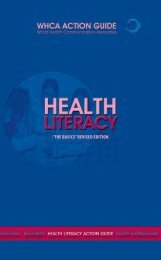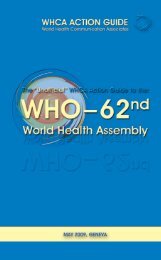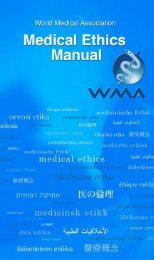Part 1 'the basics' - World Health Communication Associates
Part 1 'the basics' - World Health Communication Associates
Part 1 'the basics' - World Health Communication Associates
Create successful ePaper yourself
Turn your PDF publications into a flip-book with our unique Google optimized e-Paper software.
SECTION 3: HOW IS HEALTH LITERACy MEASURED?<br />
Most health literacy measures in current use tend to assess reading skills<br />
(word recognition or reading comprehension) and numeracy rather than<br />
measure the full range of skills needed for health literacy. There are no current<br />
measures of health literacy that include oral communication skills or writing<br />
skills and none that measure the health literacy demands within different<br />
health contexts (IOM 2004, p.51). This is an area of active research and some<br />
promising tools appear to be in the pipeline.<br />
3.1 current measurement tools—individual skills<br />
and abilities<br />
realm<br />
The Rapid Estimate of Adult Literacy in Medicine (REALM) is a word recognition test.<br />
It measures an adult person’s ability to read medical terms. Patients are asked to read<br />
a list of 66 increasingly difficult medical terms. The number of correctly pronounced<br />
words is subsequently related to approximate grade levels of reading (0-18: third<br />
grade (age 7) and below; 19-44: fourth to sixth grade (age 8-10); 45-60: seventh and<br />
eighth grade (age 11-12); 61-66: ninth grade and above (age 13+)). REALM is simple,<br />
brief (administered in two to three minutes), and useful for profiling patients’ reading<br />
skills (http://www.ihs.gov/nonmedicalprograms/healthed/PDF/PtEd_REALM_Examiner_<br />
WordList.PDF).<br />
tofhla and s-tofhla<br />
Comprehension tests—such as the Test of Functional <strong>Health</strong> Literacy in Adults<br />
(TOFHLA) and the Short Test of Functional <strong>Health</strong> Literacy in Adults (S-TOFHLA)—<br />
were designed to provide a broader assessment of functional health literacy. They<br />
take into account reading comprehension and quantitative literacy (numeracy).<br />
TOFHLA and S-TOFHLA have been shown to be reliable and valid measures<br />
of functional health literacy. Although TOFHLA and S-TOFHLA are the primary<br />
instruments by which reading comprehension and numeracy skills are measured,<br />
the time—22 minutes for the TOFHLA and 12 minutes for the S-TOFHLA—and<br />
complexity have limited their use to research within health care environments.<br />
Section Section 3: 2: How wHy iS HealtH literacy important? meaSured?<br />
17






